
Carbon fiber is one of the most sought after material in motorsports where it is five times stronger than steel and bears only one-third the weight. With such characteristics, it is no surprise that racing cars and hardcore road banshees use a lot of this material to minimize their weight and maximize very single horsepower available.
But we do not see such material being utilized on our normal, daily-commuting cars as aside from taking a long time to produce, it is also very expensive. Seriously considering the advantages carbon fiber could bring to such vehicles such as a lighter weight and a better fuel consumption, Ford had taken the cons that came with carbon fiber and offered a new alternative, called the carbon fiber reinforced plastic (CFRP).
“Reducing a vehicle’s weight can deliver major benefits for fuel consumption but a process for fast and affordable production of carbon fiber automotive parts in large numbers has never been available”, quoted advanced materials and processes research engineer in Ford’s European Research Centre, Inga Wehmeyer.
Displayed on a Focus bonnet over at the Composites Europe event at Dusseldorf, Germany, the CFRP bonnet offers a 50-percent reduced weight than a conventional steel bonnet. This new innovation also has a shorter production time that allows it to be utilized in regular assembly lines without any major hassle.
This project has been on the move since 2010, and it involves several specialists from the Institute of Automotive Engineering at Aachen University, Henkel, Evonik, IKV, Composite Impulse and Toho Tenax. They are trying hard to come up with a cost-effective method that could actually make body panels out of carbon fiber composites, and at the same time meeting painting standards and reducing production time.
Although they had reached a great milestone in improving the manufacturing speed and reducing the cost, the CFRP bonnet seen on the Focus will not be seen in the production lines anytime soon as they are still in the development stage.




